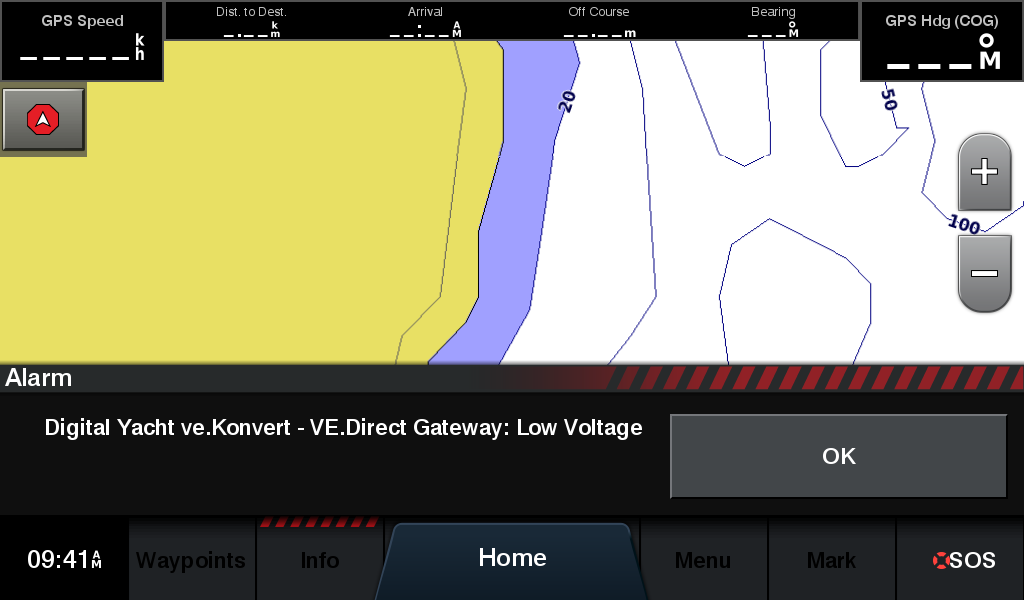In the summer of 2012, the NMEA Organisation published a set of new NMEA 2000 PGNs that added powerful and important Alert/Alarm functionality to the NMEA 2000 standard.
Until that point individual PGNs had handled specific alarm conditions by having a custom, “hard coded” alarm enumeration field, where a list of predefined alarms were decided when the PGN was developed. For instance, the list built into PGN 127489 Engine Parameters Dynamic includes common notifications like low oil pressure and high coolant temperature. But changes or updates to these custom alarm lists were extremely rare, as all existing equipment would need to be updated for the new alarm to be supported.
To overcome this shortcoming of the original PGN alarm field method, a completely new Alert system was designed with six new PGNs and a massive database of predefined Alert IDs, encompassing all areas of marine equipment operation and use. Recognising that any such database would always need updating and expansion, the system was designed so that new custom alerts could be added at any time. Compatible equipment would support any future custom Alert with no change to the receiving equipment’s firmware. Figure 1 shows how a Garmin MFD will display an NMEA 2000 Alert.

This new system allows Alerts to be transmitted in English or in the local language, and also supports real-time acknowledgement, silencing and escalation if the alert condition is not cleared. This is functionality that the PGN alarm field method could never hope to support.
In terms of interoperability, the NMEA 2000 Alert PGNs allow any alarm system or MFD (regardless of manufacturer) to receive a safety critical alert and immediately display and sound an alarm, with full details of which device created the alert and what type of alert has been triggered. The same device can silence or clear the alert and all other devices on the network will see this interaction and take appropriate action. A typical Alerts Status monitor screen is shown in Figure 2.

Hundreds, if not thousands, of industry expert man-hours went into the design of this NMEA 2000 Alert system, and it is intended to play an important part in NMEA 2000 development, impacting the design of future PGNs. NMEA 2000 technical working groups and committees, tasked with designing new NMEA 2000 functionality, are relying on the Alerts system to take care of any alarm or error communication. In addition, Alerts will also be supported by OneNet gateways to allow low-level alerts on NMEA 2000 devices to be communicated to high-level OneNet systems.
So it might come as a shock to discover that implementation by manufacturers of the NMEA 2000 Alerts, has been very low. With the exception of Garmin, none of the large MFD manufacturers support the Alert PGNs and only a few manufacturers are building products that transmit or receive these Alerts.
During our investigation and tests, we only managed to get Garmin MFDs to display and control Alert PGNs, which is good news for Garmin but not for boat owners wishing to use other makes or MFDs. Earlier this year, we got excited when we found that Raymarine were declaring that their LightHouse V4 supported the Alert PGNs, but their implementation appears to be fairly restricted and we were unable to get them to receive any alerts from our NAVAlert unit.

When you have an NMEA 2000 network with Alert compatible devices on it, good things can start to happen. Alerts generated by one manufacturer’s device, can immediately trigger safety critical alarms on devices from other manufacturers, even for alerts that those devices have no knowledge of or that were invented years after the MFD was developed. Additional network devices can centrally manage, log and control, all of the alerts that occur on the network, sound their own alarm buzzer and even send an SMS message to your phone, if you are away from the boat.
It is not uncommon for manufacturers to only implement some of the available NMEA 2000 PGNs and if this issue was just related to some systems having extra functionality and gaining an advantage over their competition, then supporting Alert PGNs would not be so important. But when manufacturer lethargy limits effective alarming for new NMEA 2000 networked technologies – like electric propulsion, cybersecurity, bow/stern thrusters, etc. – then it becomes a critical threat to our industry.
Support for Alerts in OneNet is mandatory for any manufacturer wishing to develop and certify a OneNet product and with hindsight, it might have been better if the same had happened in NMEA 2000 when Alerts were first published, but we are where we are and there is no going back.
It is time for manufacturers to wake up to how important NMEA 2000 Alerts are for the sake of our industry, and to develop a timely and effective implementation plan for their current and future products to support NMEA 2000 Alerts. The user benefits are clear and compelling and failure to include support for Alerts, will ultimately affect the performance of all future NMEA 2000 and OneNet networks.






